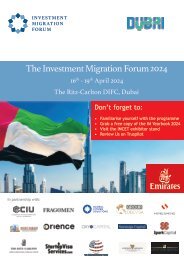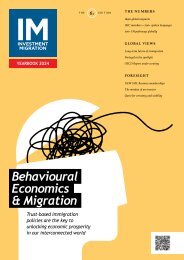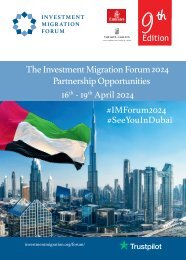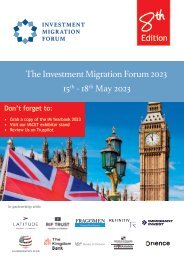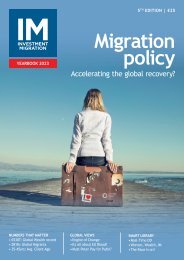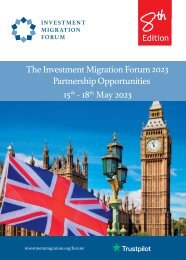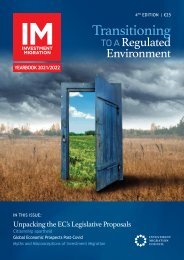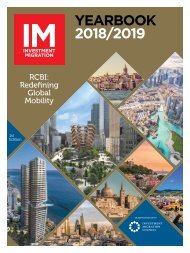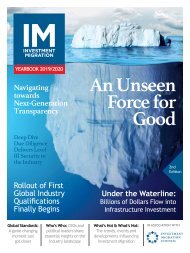IM Yearbook 2020/21
Born from the need for a global, credible, “go-to” publication, the 3rd IM Yearbook offers valuable access to a prime target audience of top industry influencers, decision makers, and the foremost referral network to the world’s most influential Investment Migration programmes: Government officials such as Heads of CIU’s, policy makers, academics, migration agents, law firms, wealth managers, financial advisors, real estate developers, and international firms involved in investment migration.
Born from the need for a global, credible, “go-to” publication, the 3rd IM Yearbook offers valuable access to a prime target audience of top industry influencers, decision makers, and the foremost referral network to the world’s most influential Investment Migration programmes: Government officials such as Heads of CIU’s, policy makers, academics, migration agents, law firms, wealth managers, financial advisors, real estate developers, and international firms involved in investment migration.
Create successful ePaper yourself
Turn your PDF publications into a flip-book with our unique Google optimized e-Paper software.
INDUSTRY OVERVIEW<br />
DOUBLING<br />
DOWN ON<br />
PROGRESS<br />
What was once a niche industry has matured and proliferated with a host of new<br />
investment migration pathways emerging around the globe. Amid changing market<br />
dynamics and growing opposition, the sector is now rising to the challenge of<br />
advancing positive trends and fast-tracking its own transformation journey.<br />
The investment migration sector<br />
began the year with nothing but<br />
prosperity on the horizon. The<br />
sector had evolved globally, with more<br />
than 100 countries offering various forms<br />
of investor visa options, including many<br />
of the world’s richest countries such<br />
as the US, UK and Australia. Growing<br />
wealth in many of the sector’s main<br />
source markets ensured that demand<br />
from high-net-worth individuals<br />
continued to expand at a robust pace.<br />
Global organisations, including the<br />
International Monetary Fund (<strong>IM</strong>F)<br />
and the World Economic Forum (WEF),<br />
described investment migration as one<br />
of fastest growing economic enablers of<br />
modern times for many small states.<br />
A few months later, the sector is<br />
contending with a wave of disruptive<br />
forces. Amid the upheaval caused by<br />
Covid-19, growth is shifting, investor<br />
priorities are changing, and the level<br />
of scrutiny is rising. The sector is still<br />
growing, but also facing powerful<br />
headwinds. The general consensus is that<br />
investment migration’s future is full of<br />
potential, but the industry must truly come<br />
together to effectively address the genuine<br />
concerns of international institutions.<br />
Beyond the surface of this billion-dollar<br />
industry, a lot of new and innovative<br />
ideas are emerging that have the power to<br />
transform investment migration into a tool<br />
for sustainable and inclusive development.<br />
A Long History<br />
Investment migration is not a new<br />
phenomenon. Some industry experts point<br />
out that it was common in the Roman<br />
Empire to grant citizenship in exchange for<br />
money, while others say that in 17 th century<br />
France, under Louis the Great, it became<br />
a widespread practice to sell noble titles<br />
to affluent commoners to finance wars.<br />
Investment migration today is understood<br />
to have its origins in the Caribbean when<br />
St. Kitts and Nevis launched the first<br />
citizenship-by-investment programme in<br />
1984 as a tool for economic development.<br />
Since then, the business model has<br />
quickly evolved and was developed<br />
further with the introduction of the golden<br />
visa concept by Portugal. In 2010, four<br />
EU member states hosted golden visa<br />
programmes, just seven years later, nearly<br />
half of all member states established<br />
them. Investment migration has grown<br />
into a global industry and is featured in<br />
immigration law in most UN recognised<br />
countries, albeit in different forms and<br />
shapes. Globally, some 60 countries are<br />
actively promoting their programmes, with<br />
30 of them being the most relevant and<br />
attracting the largest share of applicants.<br />
Countries such as the US, Canada,<br />
Australia, and the UK – all offering paths<br />
for immigrant investors – have long been<br />
among the favourite destinations of<br />
high-net-worth individuals. Citizenshipby-investment<br />
programmes are estimated<br />
to receive 5,000 applications per year,<br />
while tens of thousands of wealthy<br />
migrants are acquiring golden visas<br />
globally, generating billions in investments<br />
that are being mobilised to create jobs<br />
and encourage economic activity.<br />
10<br />
Investment Migration <strong>Yearbook</strong> 2O2O/2O<strong>21</strong>




